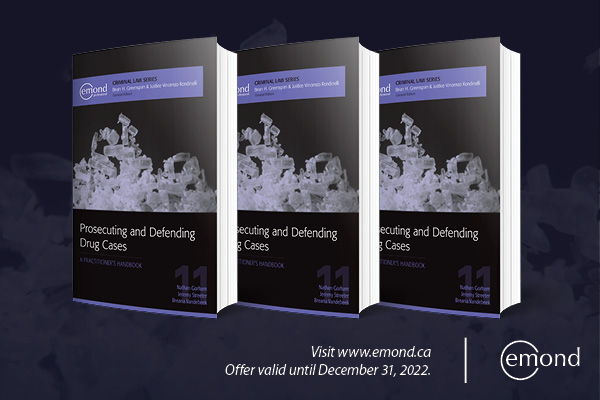This week’s top three summaries: R v Ames, 2022 ONSC 5039: #possession and stmt, R v JC, 2022 ONSC 4991: res judicata, and R v Biring, 2022 ONSC 2678: defence Vukelich.
This week's top case deals with possession an issue that arises most often in drug cases. For great general reference on principles of law often discussed in drug cases, I recommend the Emond title below. It is available for purchase now for our readership with a 10% discount code provided below. To purchase, simply click on image below.
R v Ames, 2022 ONSC 5039
[September 2, 2022] Possession and Circumstantial Evidence: "If you find something, it's all mine." [Justice Doi]
AUTHOR’S NOTE: The accused in this case most definitely did not get the memo from defence counsel to maintain his silence. After unsuccessfully trying to escape through a basement window of a raided residence he was being walked out of the house and told police "If you find something, it's all mine." Police found a handgun wedged in a sofa under a jacket in the basement and drugs elsewhere. This case stands as a useful factual scenario for the application of the circumstantial evidence test to possession even where there is a statement from the accused.
OVERVIEW
- The gun seized was a Glock .45 calibre;
- The gun was loaded with live ammunition;
- The gun was carelessly stored;
- Mr. Ames was on a weapons prohibition on October 2, 2018;
- Mr. Ames did not have a firearms license in 2018;
- S.P. and D.G. were charged with the same offences as Mr. Ames, save for the weapons prohibition charge, and C.W. was charged with the exact same charges as Mr. Ames;
- S.P., D.G. and C.W. all provided statutory declarations saying that they did not know about the presence of the gun at the subject residence nor have care or control of the gun;
- S.P., D.G. and C.W. all had their charges withdrawn prior to trial dates being set;
- At the time of Mr. Ames’ arrest on October 2, 2018, there was a warrant out for his arrest; and
- Mr. Ames never resided at the home where the subject gun was found.
BACKGROUND
[14] Police did not determine who owned the black jacket or the drugs found in the basement.
LEGAL PRINCIPLES
[23] Subsection 4(3) of the Criminal Code sets out three (3) types of illicit possession, namely personal, constructive and joint possession: R. v. Morelli, 2010 SCC 8 at para 15. The Crown’s case is solely based on constructive possession which is the only relevant form of possession that arises in this matter.
Constructive possession is established when an accused does not have physical custody of an object but knowingly has it in the actual possession or custody of another person or has it in any place for their own or another’s use or benefit: Criminal Code, s. 4(3)(a); R. v. Morelli, 2010 SCC 8, [2010] 1 S.C.R. 253, at para. 17; and R. v. Lights, 2020 ONCA 128, 149 O.R. (3d) 273, at para. 47;
Knowledge and control are essential elements of constructive possession, which is established when the Crown proves beyond a reasonable doubt that the accused: (i) has knowledge of the character of the object said to be possessed; (ii) knowingly puts or keeps the object in a particular place, whether or not the place belongs to or is occupied by the accused; and (iii) intends to have the object in the place for the use or benefit of the accused or another person: Morelli, at paras. 15, 17; Lights, at paras. 44, 47;
Tenancy or occupancy of a place where an object is found does not create a presumption of possession: Lights, at para. 50; R. v. Watson, 2011 ONCA 437, at para. 13; R. v. Lincoln, 2012 ONCA 542, at paras. 2-3; and R. v. Bertucci (2002), 2002 CanLII 41779 (ON CA), 169 C.C.C. (3d) 453 (Ont. C.A.), at para. 18; and
When the Crown relies largely or wholly on circumstantial evidence to establish constructive possession, a conviction can be sustained only if the accused’s knowledge and control of the impugned objects is the only reasonable inference on the facts. The trier of fact must determine whether any other proposed way of looking at the case as a whole is reasonable enough to raise a doubt about the accused’s guilt, when assessed logically and in light of human experience and common sense: see R. v. Villaroman, 2016 SCC 33, [2016] 1 S.C.R. 1000, at paras. 55-56; Lights, at para. 39; and R. v. Stennett, 2021 ONCA 258, at paras. 60-61. [Emphasis added]
ANALYSIS
[33] ...By blurting, “[i]f you find something it’s all mine,” the Crown submits that Mr. Ames clearly shared his comment with police to shield others from criminal liability by referring to the illegal handgun and drugs that were found in the basement as being in his possession. Although the drugs were in plain sight, the firearm was hidden in the sofa under the black jacket that, in the Crown’s submission, explains Mr. Ames’ initial “if you find something” remark by implying the need for some effort (i.e., by lifting the jacket) to find what he was alluding to. Claiming that Mr. Ames knew of the handgun and the drugs, the Crown submits that he desperately tried to flee the home by trying unsuccessfully to crawl through the barred basement window to evade arrest and criminal liability. Taking this all into account together with the statutory declarations from the others, the Crown submits that the court may find Mr. Ames guilty of the charges by making common sense inferences that he knew and maintained control of the hidden handgun.
R v JC, 2022 ONSC 4991
[September 1, 2022] Res Judicata [Justice Schreck]
AUTHOR’S NOTE: Res Judicata is not often litigated. Although in this case, the defence sought to lead evidence about what happened in a prior trial from which there was no appeal on the issue, the result is helpful primarily for defence lawyers dealing with re-trials. The case is a useful review of the principles that apply to this doctrine.
[2] This will be J.C.’s second trial on these charges. He was initially convicted of them following an earlier judge-alone trial, but was acquitted of a second sexual assault charge as well as a charge of voyeurism. The convictions were set aside following a successful appeal. There was no appeal of the acquittals.
[3] At the first trial, the complainant testified that J.C. made a sexual video of her and that she did not consent to the sexual activity in the video or the making of it. She testified that the applicant then threatened to post the video on the internet unless she had sex with him. Because of the threat, she had sex with him on several occasions and was also coerced by him to have sex with his friends. The trial judge at the first trial was not satisfied beyond a reasonable doubt that the complainant did not consent to the sexual activity in the video, or that it was made surreptitiously, and accordingly acquitted J.C. of voyeurism and one count of sexual assault. The trial judge was satisfied that J.C. threatened to post the video unless the complainant had sex with him and accordingly convicted him of extortion and sexual assault. As noted, those convictions were set aside on appeal.
[4] J.C. applies to have three categories of evidence admitted. First, despite J.C.’s acquittal, both he and the Crown wish to have the complainant testify that the sexual activity in the video was not consensual. They both agree that the jury should be told of the acquittal at the first trial, and J.C. goes further and submits that the jury should be instructed that it is bound to conclude that the complainant’s evidence that the sexual activity was not consensual was false. Second, J.C. wishes to adduce evidence of earlier consensual sexual encounters between him and the complainant in support of a defence of honest but mistaken belief in communicated consent. Third, he wishes to cross-examine the complainant on her allegation that she was coerced into having sex with his friends. Although no charges are based on that allegation, he wishes to expose inconsistencies in the complainant’s evidence.
[5] I have concluded as follows:
(1) The complainant’s evidence about non-consensual activity during the making of the video is inadmissible by virtue of both the doctrine of issue estoppel and because it is evidence of discreditable conduct whose prejudicial effect outweighs its probative value. As a result, the s. 276 issue does not arise.
(2) The evidence of earlier consensual sexual encounters between J.C. and the complainant is of marginal relevance and does not meet the requirements of s. 276.
(3) The complainant’s evidence with respect to sexual activity with J.C.’s friends is relevant to her credibility and admissible.
The following reasons explain these conclusions.
II. ANALYSIS
B. The Complainant’s Evidence About the Making of the Video
(ii) The Doctrine of Issue Estoppel
(a) The Doctrine
[31] First, the issue must have been decided in favour of the accused in the prior proceeding, that is, the finding must be logically necessary to the verdict of acquittal: Mahalingam, at para. 53; R. v. Punko, 2012 SCC 39, [2012] 2 S.C.R. 396, at paras. 7-8. This is a factual issue which the defence bears the onus of establishing: Mahalingam, at paras. 26, 52. Whether the issue was resolved in the accused’s favour on the basis of a positive factual finding or a reasonable doubt does not matter for the purposes of the doctrine: Mahalingam, at paras. 22-23, 28; R. v. Grdic, [1985] S.C.R. 810, at p. 825.
[32] Second, the determination of the issue must be final. Issues determined at trial are final, unless set aside on appeal: Mahalingam, at para. 55.
[33] Third, there must be mutuality, that is, the parties must be the same in both the earlier and the subsequent proceedings: Mahalingam, at para. 56.
[34] The doctrine of issue estoppel clearly applies in this case. The issue of whether the complainant consented to sexual activity with the applicant at the time the video was made was clearly decided in his favour at the first trial. The applicant’s identity was not in issue, nor was there any issue that there had been sexual contact between him and the complainant (which the video conclusively demonstrated). The only issue at the first trial was whether the complainant had consented. The first trial judge was not satisfied beyond a reasonable doubt that she had not.
(b) No Residual Discretion
(c) The Doctrine is a Shield, Not a Sword
(d) Can the Doctrine Be Waived?
[41] In any event, protection of the accused is only one of the purposes of issue estoppel. It has other purposes that go beyond the interests of the accused. As explained in Mahalingam, at para. 45, issue estoppel protects “the integrity and coherence of the justice system as a whole.” This protection is not the applicant’s to waive.
[42] The doctrine also protects “the related institutional values of judicial finality and economy,” which are “essential to preserving confidence in the justice system”: Mahalingam, at para. 46. This is also something which the applicant cannot waive.
(e) The Doctrine as Evidence
(iv) How the Evidence Can be Used
[56] The jury will have to learn of the existence of the video. In my view, this could be accomplished through an ASF outlining the existence of the video and a general description of its contents. The jurors could be instructed that there is no evidence as to the provenance of the video and that they should not speculate in this regard.
[57] The Crown submits that it is necessary for the jury to view the video. Counsel for the applicant takes the position that it is not necessary, and counsel for the complainant vigorously objects to it being played. In my view, allowing the jury to see the video would be deeply injurious to the complainant’s privacy and dignity and is unnecessary for a resolution of the central factual issue which must be determined in relation to it, which is whether the applicant threatened to post it on the internet. As a result, the Crown may not play the video at trial.
D. The Complainant’s Evidence About Sexual Activity With the Applicant’s Friends
(i) Overview
[69] The Crown does not intend to adduce this evidence at the retrial. However, counsel for the applicant wishes to cross-examine the complainant with respect to it in order to expose inconsistencies between her testimony and her statement to the police. The applicant takes the position that there were significant inconsistencies with respect to the number of friends she had sex with and her descriptions of them. The Crown does not object to this evidence being adduced for this purpose. Counsel for the complainant submits that the evidence is inadmissible.
(ii) Applicability of Section 276
(iii) Relevance to Credibility
[68] In her statement to the police, the complainant stated that the applicant coerced her into having sex with his friends by threatening to post the video if she did not. She also testified about this at the first trial without objection from the defence on the basis that it was relevant to the extortion charge. The applicant denied telling the complainant to have sex with his friends and any knowledge that she had done so. The first trial judge made no findings with respect to this evidence: J.C. (S.C.J.), at para. 113, FN 9.
[69] The Crown does not intend to adduce this evidence at the retrial. However, counsel for the applicant wishes to cross-examine the complainant with respect to it in order to expose inconsistencies between her testimony and her statement to the police. The applicant takes the position that there were significant inconsistencies with respect to the number of friends she had sex with and her descriptions of them. The Crown does not object to this evidence being adduced for this purpose. Counsel for the complainant submits that the evidence is inadmissible.
(ii) Applicability of Section 276
(iii) Relevance to Credibility
[72] The apparent inconsistences in the complainant’s account are directly relevant to her credibility: Barton, at para. 65; R. v. Crosby, [1995] 2 S.C.R. 912, at paras. 9-11. If the inconsistencies lead the jury to reject the complainant’s evidence about having sex with the applicant’s friends, this may well impact on her credibility with respect to being coerced to have sex with the applicant.
[73] This case turns entirely on an assessment of the credibility of the applicant and the complainant. There were no other witnesses at the first trial, and there was no independent evidence confirming or refuting the testimony of either of them. In these circumstances, evidence that relates to the complainant’s credibility is critical to the applicant’s ability to make full answer and defence.
(iv) Conclusion
III. DISPOSITION
R v Biring, 2021 BCSC 2678
[December 3, 2021] Charter s.8 - Consent of Others to Seize Video & Defence Vukelich [Justice Schultes]
AUTHOR’S NOTE: In this case, the Crown tried to respond to the s.8 Charter challenge by disputing clearly established Supreme Court authorities that found that a third party could not waive the accused's reasonable expectation of privacy vis a vis the state. They even sought to use a pre-Marakah case to do it. The Defence responded with a Vukelich motion and won. The case provides an excellent way for defence counsel to prevent the misuse of the resources of the court by Crown counsel unconcerned with binding precedents or on a mission to subvert them.
INTRODUCTION
[2] The video was recorded by a security system that was maintained by the owners of the home in which the suite was located. The investigators viewed and downloaded the relevant recordings without first obtaining a search warrant. In a previous ruling, I found that the accused had a reasonable expectation of privacy in the information about their actions that was recorded by the security system, and thus had standing to argue a breach of their s. 8 Charter right.
[3] Rather than conceding that a s. 8 breach had occurred based on the warrantless search and the presumption of unreasonableness that arises from it, and proceeding directly to the question of the applicability of s. 24(2), the Crown seeks to justify the search on the basis that it was authorized by law, that the law itself was reasonable, and that the search was carried out in a reasonable manner, as set out in R. v. Collins, [1987] 1 S.C.R. 265 at para. 23.
[4] The Crown rests its position on two bases: first, that the homeowners were capable of providing consent to the police for the search; and second, that I should find that there is an ancillary police power to obtain such video surveillance evidence from private homeowners in circumstances where they do not yet have the grounds to obtain a warrant.
[5] In response, the defence has made the present application, sometimes referred to as a Vukelich application from the case that first identified its applicability2, to preclude the Crown from embarking on an evidentiary hearing to demonstrate the reasonableness of this search.
Governing Principles
[372] The “Vukelich application”, as it has come to be known, allows a party to apply to the court to dismiss, on a summary basis, an application for an evidentiary hearing. This process is grounded in the fact there is no automatic right to a voir dire in a criminal trial. Rather, the appropriate procedure to follow in a particular case is a matter to be decided by the trial judge in accordance with their trial management powers.[373] Vukelich described the applicable threshold as being a question of whether a full hearing would “assist the proper trial of the real issues” or whether the grounds put forward in the application disclose any basis for the judge to issue the remedy sought: at para. 26. More recently, the Supreme Court of Canada has articulated this standard as requiring an application to have a “reasonable prospect” of success or of assisting in determining the issues before the court: R. v. Pires . . . R. v. Cody [citations omitted] . . . This assessment is based on an assumption that the allegations advanced in the proposed application could be proven: R. v. Frederickson, [citation omitted].
...
[403] On a Vukelich application, the judge should assume the facts the applicant seeks to prove as true and assess whether those facts, assuming they are ultimately proven, are legally capable of supporting the remedy sought. If the remedy could not flow from the facts alleged, the judge may exercise their discretion not to hold an evidentiary hearing . . .
[Emphasis in original]
[406] The Vukelich hearing was introduced as an expedient process designed to prevent undue delay or potential abuse arising from frivolous applications for voir dires in circumstances where the applicant is unable to demonstrate that the results of the hearing could affect the admissibility of the impugned evidence at trial . . . Similarly, Vukelich applications have been used to screen other applications that have no reasonable prospect of success, including applications for a stay of proceedings based on an alleged abuse of process . . .[407] Vukelich applications were “never intended as a tool by which to prevent legitimate investigation of alleged Charter breaches” or to be a “protracted pre-hearing examination of the minutiae of the accused’s application” . . . Extensive submissions concerning the ultimate merits of an application at the Vukelich hearing stage without the full evidentiary foundation have the potential to unduly limit the ambit of the inquiry that should be undertaken, resulting in an injustice . . . Ironically, this can sometimes lead to circumstances in which Vukelich applications unnecessarily extend the length of the court’s inquiry into the issue, contrary to the goal of minimizing delay and improving efficiency in the conduct of legitimate applications and motions.
[9] There is another situation in which short-circuiting an evidentiary hearing by this type of application is not appropriate, and that is where the applicable legal principles to be applied to the assumed facts are not sufficiently clear or settled....
Response to Crown’s Arguments and Authorities
[12] In Cole, the accused's work-issued laptop, which he was permitted to use for incidental personal purposes, had been found to contain child pornography by a technician who was performing maintenance on it on behalf of the employer. The police had seized the laptop and searched its contents for evidence of the crime, without the accused's consent or any prior judicial authorization. As in this case, the subject matter of the search was defined as the informational content of the laptop's hard drive. The Court noted that computers used for personal purposes in a matter to whom they belong contain a wide variety of personal details and that the ownership of the computer, while a relevant consideration in the analysis, did not deprive this accused of a privacy interest in that personal data. The fact that they had received the laptop from the employer did not “afford [them] warrantless access to the personal information contained within it”. The information remained “subject...to [the accused]'s reasonable and subsisting expectation of privacy” (para. 73).
[13] Most significantly for the present purposes, the Court rejected the proposition that a third party can waive a person's privacy interest....
...This conclusion was expressed in what the defence characterizes as broad and definitive terms:
[79] I would therefore reject the Crown’s contention that a third party could validly consent to a search or otherwise waive a constitutional protection on behalf of another.
[43] ... [W]hile it is reasonable to ask citizens to bear the risk that a co- user of their shared computer may access their data on it, and even perhaps discuss this data with the police, it is not reasonable to ask them to bear the risk that the co-user could consent to the police taking this computer. In Marakah, this Court held that, when a claimant shares information with another person through a text message, he accepts the risk that this information may be disclosed to third parties. But that does not mean the claimant “give[s] up control over the information or his right to protection under s. 8” (para. 41 [of Marakah]).[44] I cannot accept that, by choosing to share our computers with friends and family, we are required to give up our Charter protection from state interference in our private lives. We are not required to accept that our friends and family can unilaterally authorize police to take things that we share. The decision to share with others does not come at such a high price in a free and democratic society. . . .
[45] ... Although the legitimate interests of third parties can, in some circumstances, attenuate a reasonable expectation of privacy . . . they cannot eliminate it. I would note that [the accused's spouse] was of course free to, and did, notify the police about what she saw on the computer. Further, while [the accused's spouse] also had a reasonable expectation of privacy in the computer data, she is not the claimant in this appeal. . .
[16] In light of this analysis, the defence argues that the Crown's reliance on the decision of our Court of Appeal in R. v. Clarke, 2017 BCCA 453, which was decided before Reeves and is referred to in it, renders the police action in this case reasonable. In Clarke, the Court of Appeal found that a tenant's consent for the police to enter a residence that was jointly owned by the accused and his mother and carry out a search was valid as far as it dealt with shared common spaces. However, it could not extend to a search of what was identified as exclusively the accused's property. The tenant had no overlapping interest in that space. The principles set out in Cole precluded an effective waiver of his Charter rights in that space.
[25] Despite the lesser degree of privacy attaching to video recordings of tenants in common parts of the property, and the lack of deliberate involvement of the tenant in placing their personal information on that video system, it is still difficult to see how those cases' prohibition of waiving the tenant's right to assert that privacy interest can be distinguished here.
[125] ... While it might be arguable that condominium residents could not reasonably expect that building management would be unable to share with the police video recordings from cameras that management had installed for its own purposes, it does not follow that residents would reasonably expect building management to permit the police to install cameras for the police’s own purposes.[126] The installation of hidden cameras by the state is not something that condominium residents would reasonably expect the board to do in carrying out its management duties.
[30] There is no evidence in the will-say statements or the submissions of the Crown previewing an evidentiary hearing that would suggest a delegated consent to the owners by the accused to share the information beyond that scope, so as to supplant or modify those findings in the previous application. Indeed, the will-says indicate there was no written tenancy agreement, and that the issue of the CCTV was not discussed.
[31] As we know from Reeves at paras. 49 to 52, consent by a third party is only valid if it encompasses the rights holder's own informed and voluntary consent....
[33] This conclusion is also determinative of the ancillary powers argument, since the consent of the owners that I have rejected as a potentially viable legal authorization is also an essential component of the Crown’s position on this issue.
[34] I would go farther, and say that the only gap to which the power being proposed could conceivably apply is the current inability of police officers to seize items without a warrant, in circumstances in which they do not have the grounds to obtain one, and none of the other established exceptions to the unreasonableness of warrantless seizure, such as a search incidental to arrest of objects in plain view, or on the basis of valid consent from the rights holder, applies. It appears to me that this proposed power is tailored to the necessity of the current situation, solely to excuse the particular actions of the officers here, and that it would expand police powers in a way that is not justified by any gap in their general powers of search.
[35] If such a power were found to exist, it would amount to a right to preview this category of evidence on suspicion, which would be quite out of step with the accumulated body of law that has developed in relation to it.
[36] Accordingly, I find that the proposed facts could not support the remedy sought on that basis either.
[37] In light of these conclusions, the Crown will not be entitled to proceed to an evidentiary hearing on its application to justify the police actions in question as having been authorized by law.







